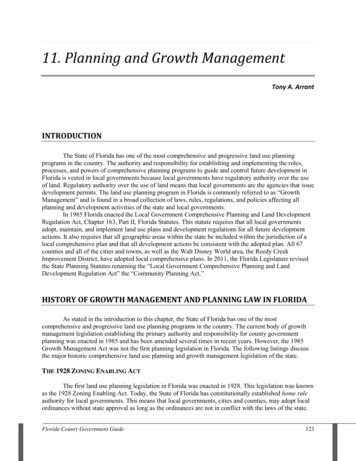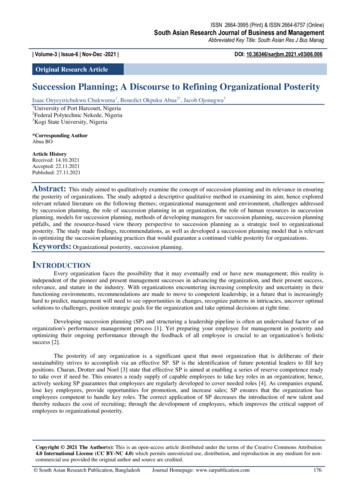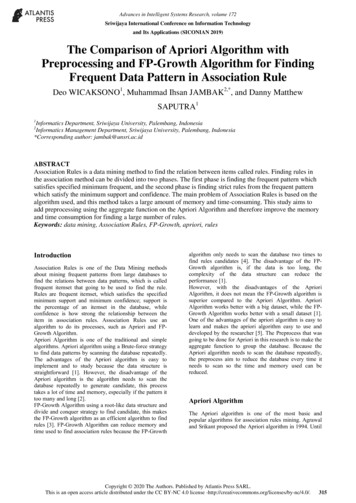
Transcription
11. Planning and Growth ManagementTony A. ArrantINTRODUCTIONThe State of Florida has one of the most comprehensive and progressive land use planningprograms in the country. The authority and responsibility for establishing and implementing the roles,processes, and powers of comprehensive planning programs to guide and control future development inFlorida is vested in local governments because local governments have regulatory authority over the useof land. Regulatory authority over the use of land means that local governments are the agencies that issuedevelopment permits. The land use planning program in Florida is commonly referred to as “GrowthManagement” and is found in a broad collection of laws, rules, regulations, and policies affecting allplanning and development activities of the state and local governments.In 1985 Florida enacted the Local Government Comprehensive Planning and Land DevelopmentRegulation Act, Chapter 163, Part II, Florida Statutes. This statute requires that all local governmentsadopt, maintain, and implement land use plans and development regulations for all future developmentactions. It also requires that all geographic areas within the state be included within the jurisdiction of alocal comprehensive plan and that all development actions be consistent with the adopted plan. All 67counties and all of the cities and towns, as well as the Walt Disney World area, the Reedy CreekImprovement District, have adopted local comprehensive plans. In 2011, the Florida Legislature revisedthe State Planning Statutes renaming the “Local Government Comprehensive Planning and LandDevelopment Regulation Act” the “Community Planning Act.”HISTORY OF GROWTH MANAGEMENT AND PLANNING LAW IN FLORIDAAs stated in the introduction to this chapter, the State of Florida has one of the mostcomprehensive and progressive land use planning programs in the country. The current body of growthmanagement legislation establishing the primary authority and responsibility for county governmentplanning was enacted in 1985 and has been amended several times in recent years. However, the 1985Growth Management Act was not the first planning legislation in Florida. The following listings discussthe major historic comprehensive land use planning and growth management legislation of the state.THE 1928 ZONING ENABLING ACTThe first land use planning legislation in Florida was enacted in 1928. This legislation was knownas the 1928 Zoning Enabling Act. Today, the State of Florida has constitutionally established home ruleauthority for local governments. This means that local governments, cities and counties, may adopt localordinances without state approval as long as the ordinances are not in conflict with the laws of the state.Florida County Government Guide123
This home rule provision was included in amendments to the State Constitution in 1968. Prior to that,local governments could not adopt local ordinances without approval of state legislation.The 1928 Zoning Enabling Act was adopted to allow local governments to approve zoningregulations to control local development and land use issues. This legislation was voluntary and did notmandate that local governments adopt land use controls, but it did allow for zoning codes to be enacted byordinance, which gave these local ordinances legal status. This legal status was important because itprovided the basis for counties to enforce the codes.THE 1972-1973 STATE AND REGIONAL COMPREHENSIVE PLANNING ACTSFor almost fifty years the voluntary zoning enabling legislation was the only land use planninglaws in Florida. However, in the 1972 and 1973 legislative sessions, the state passed two more planningacts and drafted a third.Chapter 186, Florida Statutes, was adopted to create the Regional Planning Councils (RPC).There are eleven Regional Planning Councils in Florida. All counties within the state are members of oneof the RPCs, and the RPCs’ geographic boundaries are drawn along county lines. Regional PlanningCouncils are the primary agencies responsible for planning for regional land use issues and for addressinginter-jurisdictional impacts of developments.Chapter 380, Florida Statutes, was adopted creating Developments of Regional Impact (DRI) andthe Areas of Critical State Concern. Developments of Regional Impact are developments that, based upontheir size, scale, location and/or magnitude, have a substantial effect on the citizens of more than onecounty. These large scale developments must be consistent with the local government plans, and theymust go through a special approval process where all the impacts of the development are mitigated,including extra-jurisdictional impacts. The Regional Planning Councils are the primary coordinationagency for these DRI reviews.Areas of Critical State Concern are geographic areas within the State of Florida, which theLegislature has designated in statute, that include natural resources that are significant enough to beprotected by the state. These areas include the Florida Keys, the Big Cyprus Preserve, Apalachicola Bay,and the Green Swamp. Within these areas, the state has oversight of local government developmentapproval and may object to the issuance of development permits that negatively impact the environmentalresources.The third planning act that was drafted but not enacted was the first State Comprehensive Plan.This was intended to be a comprehensive future development plan for the state. This would later becomeThe State Comprehensive Plan, Chapter 187, Florida Statutes.THE 1975 LOCAL GOVERNMENT COMPREHENSIVE PLANNING ACT,CHAPTER 163, PART II, FLORIDA STATUTESIn 1975, Florida enacted the Local Government Comprehensive Planning Act. This was thestate’s first planning legislation that required that all local governments have comprehensive land useplans. For the first time, all counties and cities were required to prepare plans that addressed the samestatewide issues and elements. However, these plans were not required to be adopted and the statute didnot give the state the authority to approve these plans.These plans, because they were not adopted and recognized by the state, did not have the legalstatus of today’s plans, and therefore were not really enforceable by local governments or propertyowners. Local development permits did not necessarily have to be consistent with these plans. The plansthat were prepared pursuant to the 1975 legislation did not require a Future Land Use Map and did notrequire any implementing land development regulations.Despite these limitations, the 1975 Local Government Comprehensive Planning Act was a verypositive experience for the state with regard to land use planning. That act resulted in a tremendousFlorida County Government Guide124
educational effort for the state. For the first time local governments, regional agencies, and the state werefocused on land planning and learning how to manage develop in orderly and efficient patterns whileprotecting the natural environment.THE 1984 STATE COMPREHENSIVE PLANNING ACT,CHAPTER 187, FLORIDA STATUTESIn 1984, Florida finally adopted a State Comprehensive Plan. Chapter 187 of the Florida Statutesprovides a series of planning goals for the State of Florida, and for each goal there are multipleimplementing policies that establish action steps for achieving these goals. This state plan is written invery general terms and covers many issues that are not directly related to land use.THE 1985 LOCAL GOVERNMENT COMPREHENSIVE PLANNINGAND LAND DEVELOPMENT REGULATION ACT,CHAPTER 163, PART II, FLORIDA STATUTESThe 1985 Act, commonly referred to as the Growth Management Act, updated the 1975 Act andwas based upon the successes and failures of previous years’ planning efforts experienced by the state andlocal governments since the adoption of the original planning legislation. One of the major revisions wasthe requirement that all local government plans and plan amendments be adopted by ordinance and thatall plans and amendments must be reviewed and approved by the state. This process results in the currentlegal status of county plans.The 1985 Act establishes the right for citizens and adjacent local governments to have legalstanding to challenge plans and amendments. That act requires that all plans be financially feasible andthat the plans include a concurrency management system, which ensures that the infrastructure needed tosupport development is available when the impacts of the development occur. The 1985 Act also requiresthat all plans include an adopted Future Land Use Map (FLUM) and that all local governments adoptimplementing land development regulations (LDRs). (Please refer to later sections of this chapter, whichdiscuss what is included in the plan elements).Since the passage of the Growth Management Act, all cities and counties within the state haveadopted comprehensive plans consistent with the 1985 legislation. There have been several statewidestudy commissions that have reviewed and recommended changes to the 1985 Act. Some specificchanges have been enacted, some have been repealed, and others are currently being studied for possiblerevision. However, the majority of the requirements for county plans are still contained in the originallanguage of the 1985 Growth Management Act.Some of the more significant revisions to the 1985 Growth Management Act relate to jointplanning and coordination between counties and cities and the school districts. In 1995 the act wasamended to: require joint planning efforts with the school districts; require that the land use elementspecifically identify land use categories that allow school facilities; and require interlocal agreements forjoint planning efforts.Later, the statute was amended to allow for a school facilities element and for optional schoolconcurrency. In 2002, a new section 163.31777, Florida Statutes, was added that requires localgovernments and school boards to enter into an interlocal agreement that addresses school siting,enrollment forecasting, school capacity, infrastructure and safety needs of schools, schools as emergencyshelters, and sharing of facilities. In 2005 the Legislature mandated that local plans include a publicschool facilities element.In addition to planning for schools, the Growth Management Act has been amended multipletimes changing requirements and adding new ones. There have been many revisions to the concurrencyrequirements and to transportation planning, as well as water resources planning. For example, in 2004the Act was revised to require local governments to identify adequate water supply sources to meet futureFlorida County Government Guide125
demand for the established planning period. Like local plans, the Growth Management Act is dynamicand evolving as new and different issues arise.THE 2011 COMMUNITY PLANNING ACTCHAPTER 163, PART II, FLORIDA STATUTESThe 2011 Community Planning Act not only renamed the Florida planning program, but it alsogreatly reduced the State and Regional agency oversight of planning and land development activity. ThisAct revised and shortened the agency review periods and limited these agencies authority to object tolocal government decisions regarding planning and land development. State and regional agenciescomments on plans and plan amendments are now limited to important state resources and facilities.State agencies can only comment when these important state resources and facilities are “adversely” or“negatively” impacted.The Community Planning Act removed the twice a year limitation on plan amendments andrepealed Chapter 9J-5, Florida Administrative Code, the minimum criteria rule for local plans. However,the Act did not significantly reduce the planning requirements for Florida’s county governments. Alllocal governments must still adopt, maintain and implement local land use plans.WHAT IS A COMPREHENSIVE PLAN?The local government comprehensive plan is a document that is prepared and adopted pursuant toChapter 163, Florida Statutes. Once a county’s plan is adopted and found to be in compliance by theDepartment of Community Affairs, it is the public policy decision making guide for all decisionsregarding development actions within the county.The Growth Management Act, now named the Community Planning Act, was enacted by theFlorida Legislature for the purposes of strengthening the existing role, processes, and powers of localgovernments in the establishment and implementation of comprehensive planning programs to guide andcontrol future development. In part, the act states that local governments shall adopt a comprehensiveplan so that they can preserve and enhance present advantages; encourage the most appropriate use ofland, water, and resources consistent with the public interest; overcome present handicaps; and dealeffectively with future problems that may result from the use and development of land within theirjurisdictions. Through the process of comprehensive planning it is intended that units of local governmentcan preserve, promote, protect, and improve the public health, safety, comfort, good order, appearance,convenience, law enforcement and fire prevention, and general welfare; prevent the overcrowding of landand avoid undue concentration of population; facilitate the adequate and efficient provision oftransportation, water, sewerage, schools, parks, recreational facilities, housing and other requirements andservices; and conserve, develop, utilize, and protect natural resources within their jurisdictions.The local government comprehensive plan is intended to be a guide for making land use decisionsfor future development and redevelopment. Florida does not have a “stop growth” planning program. TheGrowth Management Act is intended to help local officials make decisions regarding the distribution,extent, and timing of future growth. Distribution of growth means the geographic location of newdevelopment and the relationships between that development and existing development and supportinginfrastructure and the environmental resources of the area. The extent of growth refers to the amount. Ithelps local officials determine how much density of housing would be appropriate for certain locations, orhow much intensity of commercial or industrial development will be compatible in a specific location.The final characteristic of future growth that the Growth Management Act attempts to manage is thetiming of future development. Local governments must decide when permitting development, if theFlorida County Government Guide126
specific area proposed for development has the necessary supporting infrastructure and other developmentcharacteristics that support the new development.LEGAL STATUS OF THE COMPREHENSIVE PLANstating:Section 163.3194(1)(a), Florida Statutes, establishes the legal status of comprehensive plans, After a comprehensive plan, or element or portion thereof, has been adopted in conformity withthis act, all development undertaken by, and all actions taken in regard to development orders by,governmental agencies in regard to land covered by such plan or element shall be consistent withsuch plan or element as adopted.This section of the statute means that before a county issues any development order, adopts anylocal ordinance that relates to the development of property or takes any other action in regard todevelopment orders, the county must ensure that the action is consistent with the adopted provisions ofthe comprehensive plan. There is no variance to a comprehensive plan. If a local government decides toapprove a development that is not consistent with the plan, the plan must be amended first.PUBLIC PARTICIPATION IN THE PLANNING PROCESSThe Planning Act requires public participation in the comprehensive planning process, includingpreparation, adoption, and amendment of the plan. The local governing body and the local planningagency shall adopt procedures to provide for and encourage public participation in the planning process,including consideration of amendments to the comprehensive plan and evaluation and appraisal reports.The procedures shall include provisions to assure that real property owners are put on notice,through advertisement in a newspaper of general circulation in the area or other method adopted by thelocal government, of official actions that will affect the use of their property. There should be provisionsfor notice to keep the general public informed and provisions to assure that there are opportunities for thepublic to provide written comments. The required public hearings must be public noticed and held andthere must be provisions to assure the consideration of and response to public comments.Local governments are encouraged to make executive summaries of comprehensive plansavailable to the general public and should, while the planning process is ongoing, release information atregular intervals to keep its citizenry apprised of planning activities.GENERAL REQUIREMENTS OF A COMPREHENSIVE PLANIn general, the adopted comprehensive plan consists of the required element goals, objectives andpolicies, and the future conditions maps depicting future land use and future transportation conditions. Alldata and analysis, reports, and studies that support the plan do not need to be adopted. These materials areimportant but are not considered part of the adopted plan that regulates development decisions.The required elements are as follows: Future Land Use ElementHousing ElementFlorida County Government Guide127
Sanitary Sewer, Solid Waste, Stormwater Management, Potable Water and NaturalGroundwater Aquifer Recharge Element. (Infrastructure Element)Coastal Management (for those governments identified in Section 380.21, Florida Statutes).Conservation ElementIntergovernmental Coordination ElementCapital Improvements ElementTransportation ElementThe 2011 Community Planning Act made the previously required Public School FacilitiesElement and Public School Concurrency, an optional element.A Recreation and Open Space Element was a required element but now is considered an optionalelement, specifically with regards to concurrency for recreation and open space facilities. Other optionalelements that some counties have adopted include economic development elements, historical elementsand public safety elements. While these elements are optional, it is important to understand that onceadopted these optional elements have the same legal status as the required elements, which means that alldevelopment actions must be consistent with these optional adopted elements as well.Each element of the plan includes at least one long-range goal, several intermediate objectives,and multiple implementation policies. “Goal” means the long-term end toward which programs oractivities are ultimately directed. “Objective” means a specific, measurable, intermediate end that isachievable and marks progress toward a goal. “Policy” means the way in which programs and activitiesare conducted to achieve an identified goal.FUTURE LAND USE ELEMENTThis is the most recognized element of the comprehensive plan. This element includes the FutureLand Use Map (FLUM), which depicts the future land use categories. This element also contains thepolicies that establish the maximum densities for residential development and the maximum intensitiesfor non-residential development. The following details the requirements for the FLUM:(a) The proposed distribution, extent, and location of the following generalized land uses shall beshown on the future land use map or map series:1. Residential use;2. Commercial use;3. Industrial use;4. Agricultural use;5. Recreational use;6. Conservation use;7. Educational use;8. Public buildings and grounds;9. Other public facilities; and10. Historic district boundaries and designated historically significant properties meritingprotection.11. Transportation concurrency management area boundaries or transportation concurrencyexception area boundaries, if any such areas have been designated.12. Multimodal transportation district boundaries, if any such areas have been designated.(b) The following natural resources or conditions shall be shown on the future land use map ormap series:1. Existing and planned public potable waterwells and wellhead protection areas;2. Beaches and shores, including estuarine systems;3. Rivers, bays, lakes, flood plains, and harbors;4. Wetlands;5. Minerals and soils; andFlorida County Government Guide128
6. Coastal high hazard areas.(c) Mixed use categories of land use are encouraged. If used, policies for the implementation ofsuch mixed uses shall be included in the comprehensive plan, including the types of land usesallowed, the percentage distribution among the mix of uses, or other objective measurement,and the density or intensity of each use.(d) If determined by the local government to be appropriate, educational uses, public buildingsand grounds, and other public facilities may be shown as one land use category on the futureland use map or map series.(e) If the local government has determined it necessary to utilize other categories of the publicand private use of land, such categories of land use shall be shown on the future land use mapor map series.The Future Land Use Element is based upon surveys, studies, and data and analysis of the county,including the amount of land required to accommodate anticipated growth; the projected population,including seasonal population; the character of undeveloped land; and the availability of public servicesneeded to serve new development and the need for development and redevelopment. This combination ofdata and analysis must support the land use designations depicted and the Future Land Use Map. Thisdata and analysis should also form the basis for the determination of whether the plan discourages theproliferation of urban sprawl.“Urban sprawl” means urban development or uses that are located in predominantly rural areas,or rural areas interspersed with generally low-intensity or low-density urban uses, and that arecharacterized by one or more of the following conditions: (a) the premature or poorly planned conversionof rural land to other uses; (b) the creation of areas of urban development or uses which are notfunctionally related to land uses which predominate the adjacent area; or (c) the creation of areas of urbandevelopment or uses which fail to maximize the use of existing public facilities or the use of areas withinwhich public services are currently provided. Urban sprawl is typically manifested in one or more of thefollowing land use or development patterns: Leapfrog or scattered development; ribbon or stripcommercial or other development; or large expanses of predominantly low-intensity, low-density, orsingle-use development.HOUSING ELEMENTThe primary objective of the Housing Element is to address the affordability and the availabilityof housing for all segments of the county population. This element addresses the maintenance of thehousing stock, including identification and protection of historically significant structures, rehabilitationof substandard units, and provision of adequate sites for future housing with supporting infrastructure andpublic facilities.INFRASTRUCTURE ELEMENTThe local government plan must include a sanitary sewer, solid waste, drainage, potable water,and natural groundwater aquifer recharge element. This element is generally referred to as theInfrastructure Element. The goals, objectives, and policies of this element must address establishingpriorities for replacement of deficient facilities and the provision of future infrastructure facilities to servethe existing and projected population. This element also establishes “level of service standards” (LOSstandards) for all water, sewer, drainage, and solid waste facilities. These LOS standards are used in theconcurrency management system to ensure that future infrastructure is available to serve existing andfuture development.Florida County Government Guide129
COASTAL MANAGEMENTAll counties that abut the Gulf of Mexico or the Atlantic Ocean shall include a CoastalManagement Element in the local plan. This element addresses the maintenance, restoration, andenhancement of the overall quality of the coastal zone environment. The objectives and policies providefor the conservation of viable population of species of marine life, the avoidance of loss of coastal zoneresources, and the preservation of historic and archaeological resources. This element also addresses thedangers of natural disasters such as hurricanes and provides for hurricane evacuation from coastal highhazard areas (CHHA). This element also limits the expenditure of public resources that subsidizedevelopment in the CHHA.CONSERVATION ELEMENTThe local comprehensive plan must include an element for the conservation, use, and protectionof natural resources, including water, air, water recharge areas, wetlands, waterwells, marshes, soils,beaches, shores, flood plains, rivers, bays, lakes, harbors, forests, fisheries, wildlife and marine habitats,minerals, and other natural resources. The purpose of the Conservation Element is to promote theconservation, use and protection of natural resources.This element includes goals, objectives, and policies that protect air quality, conserve andappropriately use water sources, and protect minerals, soils, wetlands, floodplains, and native vegetativecommunities.INTERGOVERNMENTAL COORDINATION ELEMENTA county’s comprehensive plan should provide for and facilitate coordination with the plans ofadjacent counties, municipalities within the county and those that are adjacent to the county boundaries,and with the county school district. The plan should also establish mechanisms that ensure coordinationwith state and regional agencies in the maintenance and implementation of the plan.The Intergovernmental Coordination Element (ICE) has been historically viewed as one of theweakest and least effective elements of local plans. However, over the past several years statutoryamendments and plan updates have resulted in significant improvements to this element.Rule 9J-5, Florida Administrative Code, details the specific intergovernmental coordinationmechanisms that must now be included in the element. Some of these include: Coordination of planning activities mandated by the various elements of the comprehensiveplan with other local governments, school boards, other units of local government providingservices but not having regulatory authority over the use of land, the region, and the state. Resolution of conflicts with other local governments through the regional planning council’sinformal mediation process. Establishment of procedures to identify and implement joint planning areas for the purposesof annexation, municipal incorporation and joint infrastructure service areas;. Coordinated management of certain bays, estuaries and harbors that fall under the jurisdictionof more than one local government. Recognition of campus master plans. Establishment of joint processes for collaborative planning and decision-making with theschool board on population projections and the siting of public school facilities.Florida County Government Guide130
Establishment of joint processes for the siting of facilities with county-wide significance,including locally unwanted land uses, such as solid waste disposal facilities.CAPITAL IMPROVEMENTS ELEMENTThe purpose of the capital improvements element is to: Evaluate the need for public facilities as identified in the other comprehensive plan elementsand as defined in the applicable definitions for each type of public facility. Estimate the cost of improvements for which the local government has fiscal responsibility. Analyze the fiscal capability of the local government to finance and construct improvements. Adopt financial policies to guide the funding of improvements. Schedule the funding and construction of improvements in a manner necessary to ensure thatcapital improvements are provided when required based on needs identified in the othercomprehensive plan elements.The element shall also include the requirements to ensure that an adequate concurrency managementsystem (CMS) will be implemented. The CMS is based upon a 5-year Schedule of Capital Improvements.This is commonly referred to as the Capital Improvements Plan (CIP).The schedule of capital improvements includes all projects for which the local government hasfiscal responsibility. The projects are selected for the first five fiscal years, by year, after the adoption ofthe comprehensive plan. The CIP shall reflect the need to reduce existing deficiencies, remain abreast ofreplacements, and meet future demand. The schedule shall include a description of each project, thegeneral location of the project, and the projected costs and revenue sources being dedicated to fund theproject by year for each of the five years.The financial policies established in the element and the five-year schedule of the CIP, along withthe adopted Level of Service (LOS) standards established in the other elements, form the basis of theConcurrency Management System (CMS). The purpose of the CMS is to establish an ongoing mechanismthat ensures that public facilities and services needed to support development are available concurrentwith the impacts of such development.“Level of service” means an indicator of the extent or degree of service provided by, or proposedto be provided by, a facility based on and related to the operational characteristics of the facility. Level ofService shall indicate the capacity per unit of demand for each public facility. Level of Service standardsfor public facilities are adopted in policies in other elements and are also included in the CapitalImprovements Element. LOS standards are established for potable water systems, sanitary sewer systems,transportation facilities, solid waste facilities
Florida County Government Guide 124 This home rule provision was included in amendments to the State Constitution in 1968. Prior to that, local governments could not adopt local ordinances without approval of state legislation. The 1928 Zoning Enabling Act was adopted to allow local governments to approve zoning











